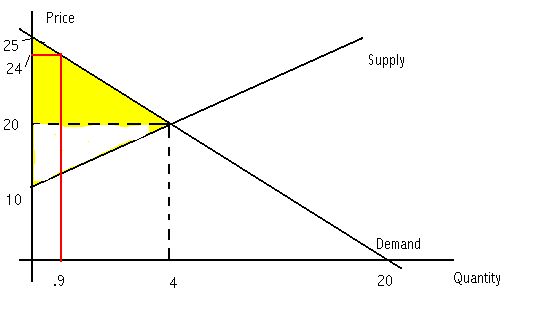Temple University
Department of Economics
Solution to the Consumer Surplus Problem Set
The demand curve can be written as Q=20-.8P or as P=25-1.25Q. For purposes of drawing
graphs as we conventionally do them the latter representation is more useful. The supply
curve can also be written two ways: Q=-4+.4P or P=10+2.5Q. For graphing purposes the
latter is easier to work with.
Setting quantity demanded equal to quantity supplied we get
20-.8P=-4+.4P
24=1.2P
P=20
Substitute P=20 back into the demand curve to get Q=20-.8(20)=4. The
equilibrium price and quantity are shown in the diagram below.

- Consumer surplus is the area under the demand curve but above the going price. In the
diagram consumer surplus corresponds to the area of the yellow triangle. The area of a
right triangle is found from formula area=(1/2)*base*height. In this example the base is
4, the height is 25-20=5. Therefore consumer surplus is .5*4*5=10.
- There are ten identical consumers. If total market demand at P=$20 is 4 then each
consumer must have purchased .4 units. Similarly, at a price of $24 the total quantity
demanded is .9, therefore each consumer must have purchased .09. At a price of $25 no one
buys anything. Applying the notion of consumer surplus to the individual, gives us
CS=.5*(.4)*(25-20)=1. The conclusion is that each buyer has a consumer surplus of 1. That
is the most any one of them would be willing to pay to become a member.
- Having to pay a ‘membership fee’ will not change
any individual’s final demand for the product. Why? At a price of $25 no one would
purchase anything. When the price falls to $24 then buyers will purchase .9 units. At the
market clearing price of $20, those who would have paid $24 for the first .9 units feel as
though they got a bargain. They ‘saved’ .9*(24-20)=$3.60 by virtue of the fact
that they need only pay the market price. Suppose we now inform this group that although
they only have to pay $20/unit for their purchases of .9 units they must also pool their
resources and pay a membership fee of $3.60. Their total expense is 20*.9+3.60=$21.60. As
far as this first group of consumers is concerned this is no different than the $24/unit
they would have paid for the first .9 units in the first place, .9*24=$21.60.

